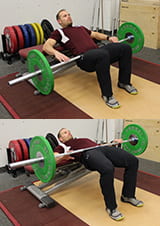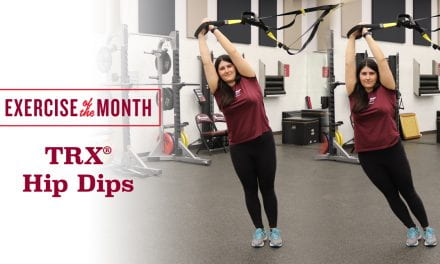Target Body Part: Gluteus Maximus
- Primary Muscles: Gluteus Maximus,
- Secondary Muscles: Biceps femoris,
- Equipment Needed: Bench, barbell with weights (full diameter), Squat pad (for comfort)
Performance Points:
- Set up a bench behind you so the height of the padding of the bench is just below your shoulder blades when your butt in flat on the floor.
- Extend your legs and roll the bar over your thighs so it sits between your thigh and stomach.
- Bend your knees and place your feet flat on the ground at approximately a 90 degree angle
- Place your hands on the bar and thrust upwards towards the ceiling as you roll your shoulder blades up and onto the bench.
- While you are doing this keep a slight round in your upper back, like you are doing a crunch, and don’t let your head fall backwards as this can lead to excessive stresses along the neck
- At the top of the thrust you need to squeeze your glutes (butt cheeks) to finish the movement.
- Let your hips slowly lower the weight down to tap the ground and repeat.
COACH’S KEY: Since your glutes are large strong muscles barbell hip thrusts should be done with proportionally heavy weights to get the results you want.
Reps/Sets:
- Done as a primary movement this should be done for 5-8 reps for 3-5 sets. If this is being done as a secondary or to maximize size in the glutes do 8-12 reps for 2-4 sets.
Modifications:
- You can place a plate underneath your feet to increase the range of motion for your glutes and increase the challenge of this exercise.
- You can put a short band around your thighs just above the knees and actively push your legs apart as you thrust upwards to increase the activation of gluteus medius and other adductors.
This exercise is just one of many gluteal activation exercises. Appropriate gluteal activation has been shown to reduce the rate of knee injuries such as, patellofemoral syndrome, ACL tears and general knee pain. Improving muscular endurance of the gluteus medius has been shown to reduce “hip drop” in long distance runners leading to more effective gait and reduced injuries. Improving gluteal activation allows for the glutes to be fired during hip extension instead of the hamstrings, which has been shown to reduce incidences of low-back pain. Improved gluteal strength allows for improved power production during explosive movements including, but not limited to, jumping, sprinting and Olympic lifting.
Visit our website for our personal trainer bios and information on fitness program designs and individual and group personal training.


